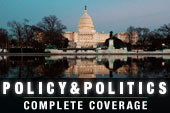It is a standard talking point of Republicans and deficit hawks of all political stripes that federal spending is out of control; that major surgery is needed, especially on entitlement programs such as Social Security and Medicare, to get the budget on a sustainable course.
In fact, our long-term deficit situation is not nearly as severe as even many budget experts believe. The problem is that they are looking at recent history and near-term projections that are overly impacted by one-time factors related to the economic crisis and massive Republican tax cuts that lowered revenues far below normal.
Taking a longer-term view, such as that in a recent Treasury Department report, shows that our longer-term fiscal problem is in fact quite manageable.

As the chart below illustrates, federal spending ballooned in fiscal year 2009 mainly because of what economists call “automatic stabilizers” – programs already in law such as unemployment compensation that rises whenever a recession occurs. Spending rose from 20.7 percent of the gross domestic product in fiscal year 2008 to 25 percent in 2009.
Republicans would have us believe that all of this resulted from Barack Obama’s policies, but this is simply a partisan lie. Fiscal year 2009 actually began on September 1, 2008, and was based on the budget that George W. Bush submitted in January 2008.
Moreover, if we look at projections from the Congressional Budget Office on January 7, 2009 – while Bush was still in office and which do not incorporate any Obama policies – we see that the deficit was projected to rise from $455 billion in 2008 to $1.2 trillion in 2009 under existing law.
The actual deficit for fiscal year 2009 was $1.55 trillion. But the difference was due entirely to lower revenues than expected, not higher spending. Outlays in fiscal year 2009 actually came in below CBO’s projection – $3,518 billion actual vs. a projection of $3,543 billion.
The point is not to assess blame for the deficit; only to emphasize the temporary nature of the historically large deficits of the last few years and show that they did not result from an explosion of new spending initiated by Obama. This is important because Republicans continually make that claim, thus justifying their belief that spending must be massively slashed, especially for entitlements.
Getting back to the chart, we see that spending for every single government program going forward is remarkably stable as a percentage of GDP. Those who complain loudest about spending and deficits nearly always base their concerns on projections of nominal spending that are unadjusted for inflation, growth of the population or growth of the economy. This is intellectually dishonest.
In fact, virtually all the growth in projected spending comes not from entitlements or giveaways to the poor and lazy, as Republicans would have us believe, but rather from interest on the debt. This is a problem, but not nearly to the extent that it appears.
The reason is that interest on the debt is what economists call a pure transfer. Economically, it is little different from taking money out of your right pocket and putting it into your left pocket. That is because the vast bulk of interest goes to people and institutions who simply use it to buy more Treasury securities.
Back in the days when the federal debt was owned almost entirely by Americans, one could reasonably say that we owed it to ourselves and it was a matter of no economic concern. As Franklin D. Roosevelt put it Our national debt after all is an internal debt owed not only by the Nation but to the Nation. If our children have to pay interest on it they will pay that interest to themselves. A reasonable internal debt will not impoverish our children or put the Nation into bankruptcy.
Of course, we no longer owe the debt all to ourselves; about half of the publicly-held national debt is owned by foreigners, but most of that is held by central banks that will hold it pretty much forever. Nevertheless, there is still a fundamental economic difference between a debt arising from higher government spending on goods and services and one arising from higher interest expense.
When government buys stuff or employs workers, they are not available for use by the private sector. If the economy were growing and the unemployment rate was low, this would be a bad thing. Under current circumstances, however, when GDP is far below its potential and unemployment is high, government spending on goods and services is not displacing private use, but rather putting otherwise idle resources to good use.
My point is that economists have long differentiated between non-interest spending and that for interest, which, as I said, is a pure transfer that has essentially benign economic effects. For this reason, they are mainly concerned about what is called the “primary deficit,” which is non-interest spending as compared to revenues. As the chart shows, the primary deficit going forward is actually quite small – just 1.7 percent of GDP in the long run.
Moreover, this estimate is high because it was calculated before the effects of the fiscal cliff deal, which substantially raised revenues and reduced projected deficits relative to the assumptions used in the Treasury report. Consequently, the long-term budget situation is better than shown in the chart. It’s difficult to estimate that effect at this time – we will get additional data within the next two weeks in the president’s budget and CBO’s annual projections.
In conclusion, it is silly to obsess about near-term nominal budget deficits. What matters is the deficit as a share of GDP minus interest spending, which economists call the primary deficit. On that basis, we are much closer to fiscal sustainability than even most economists realize. Relatively small adjustments to the growth path of federal revenues and Medicare would be sufficient to eliminate the primary deficit. Taking a meat ax to every federal program, as Republicans demand, is neither necessary nor desirable.






